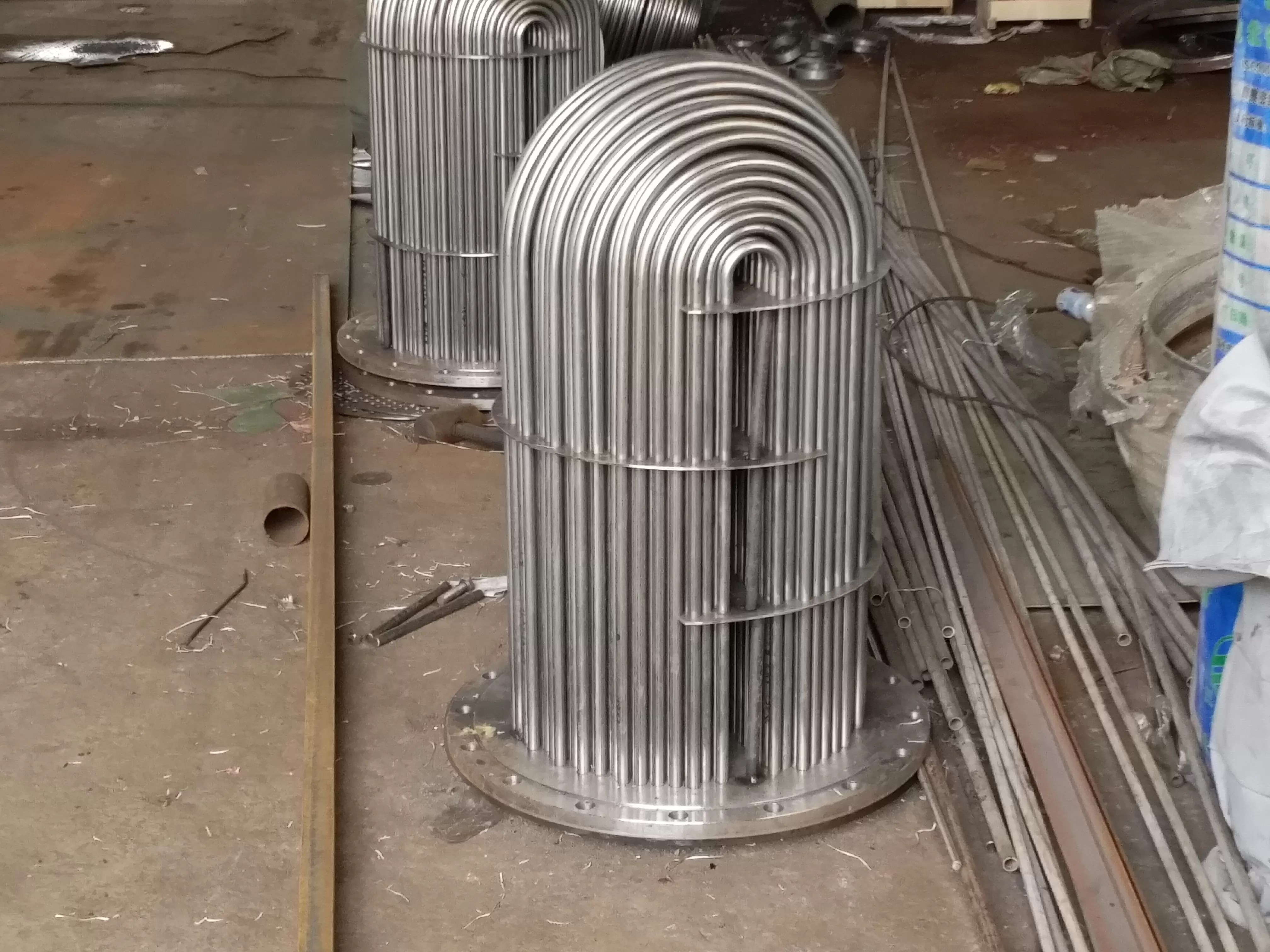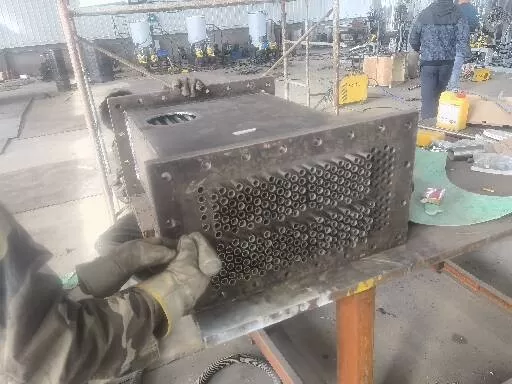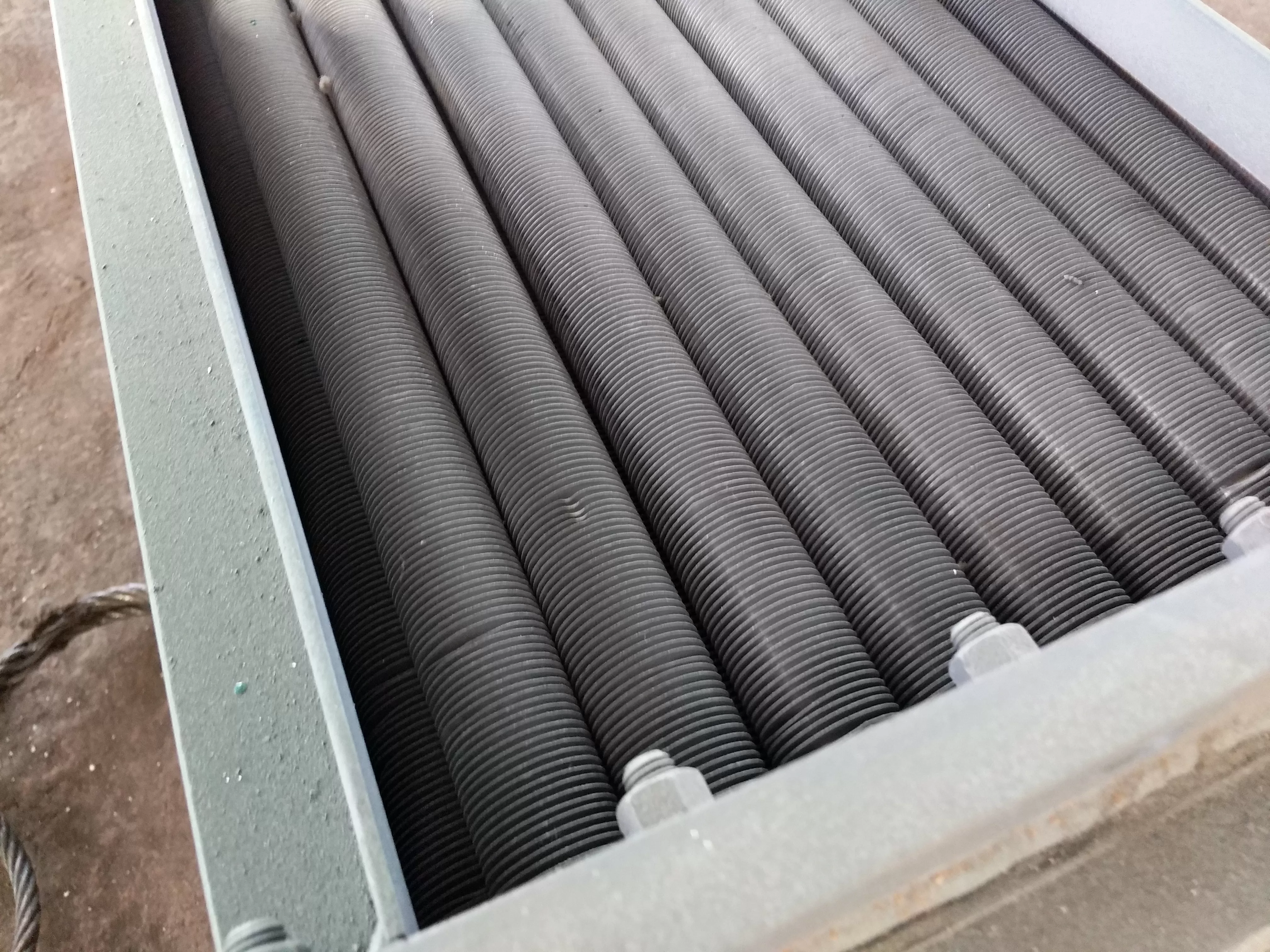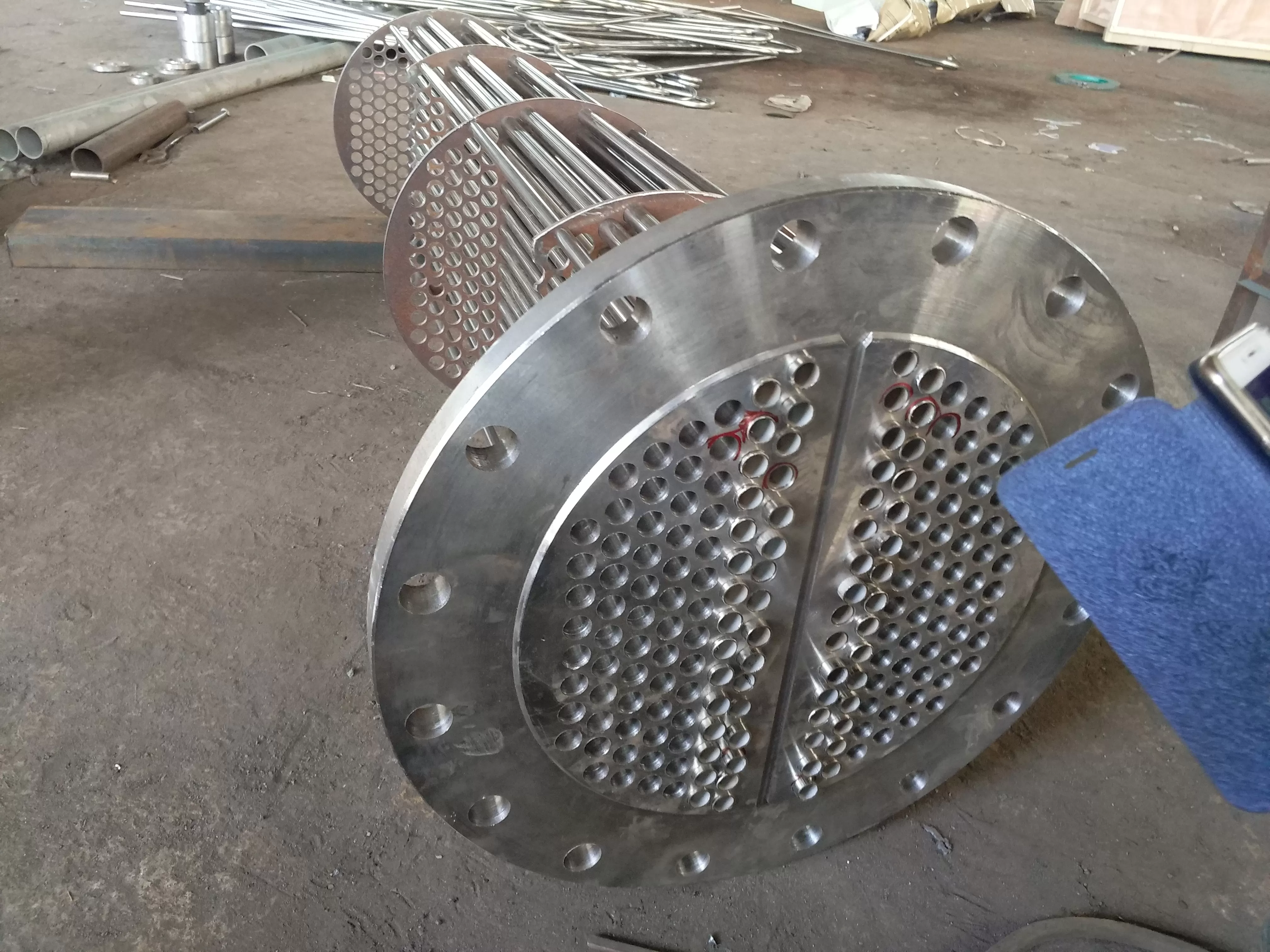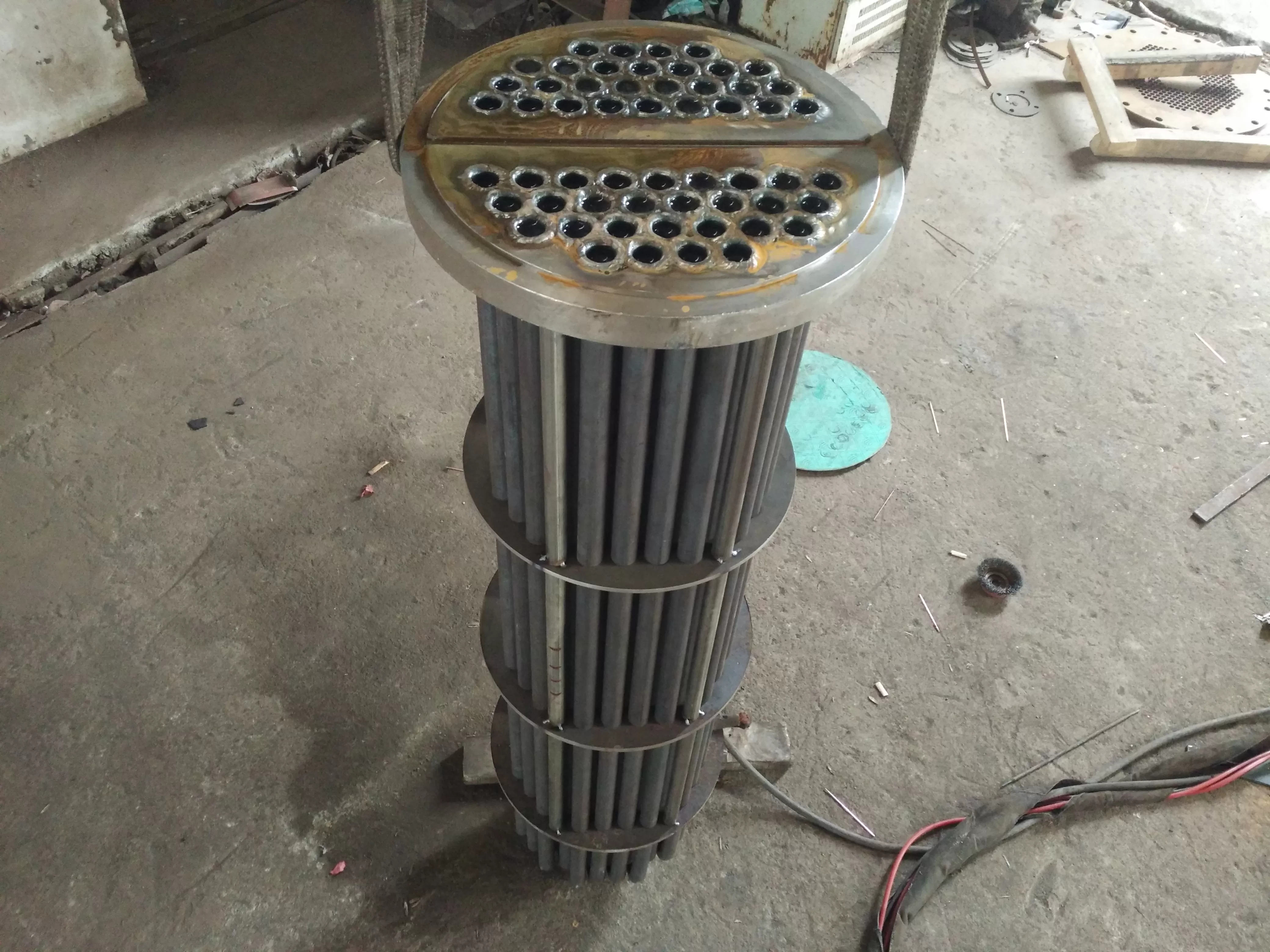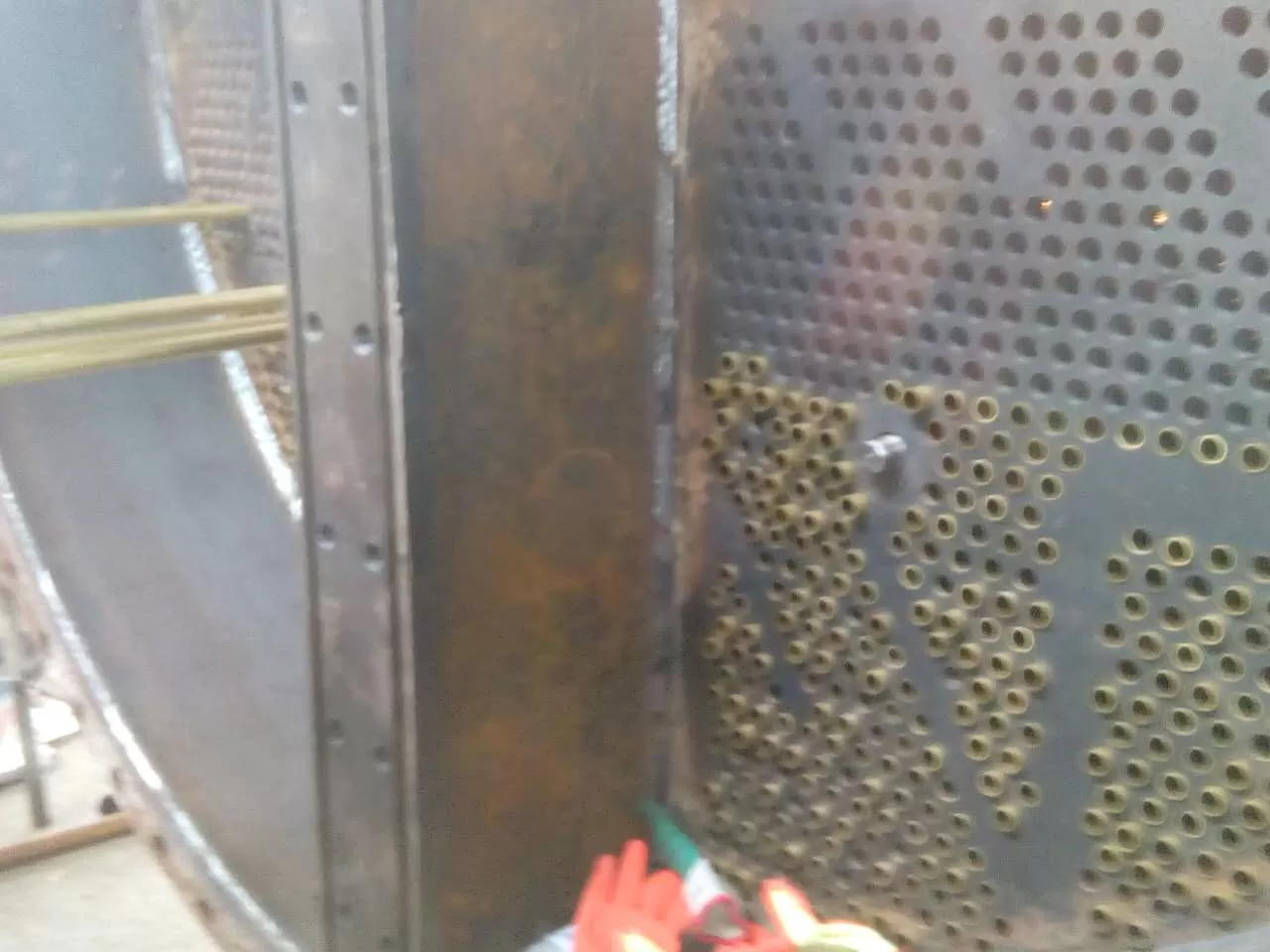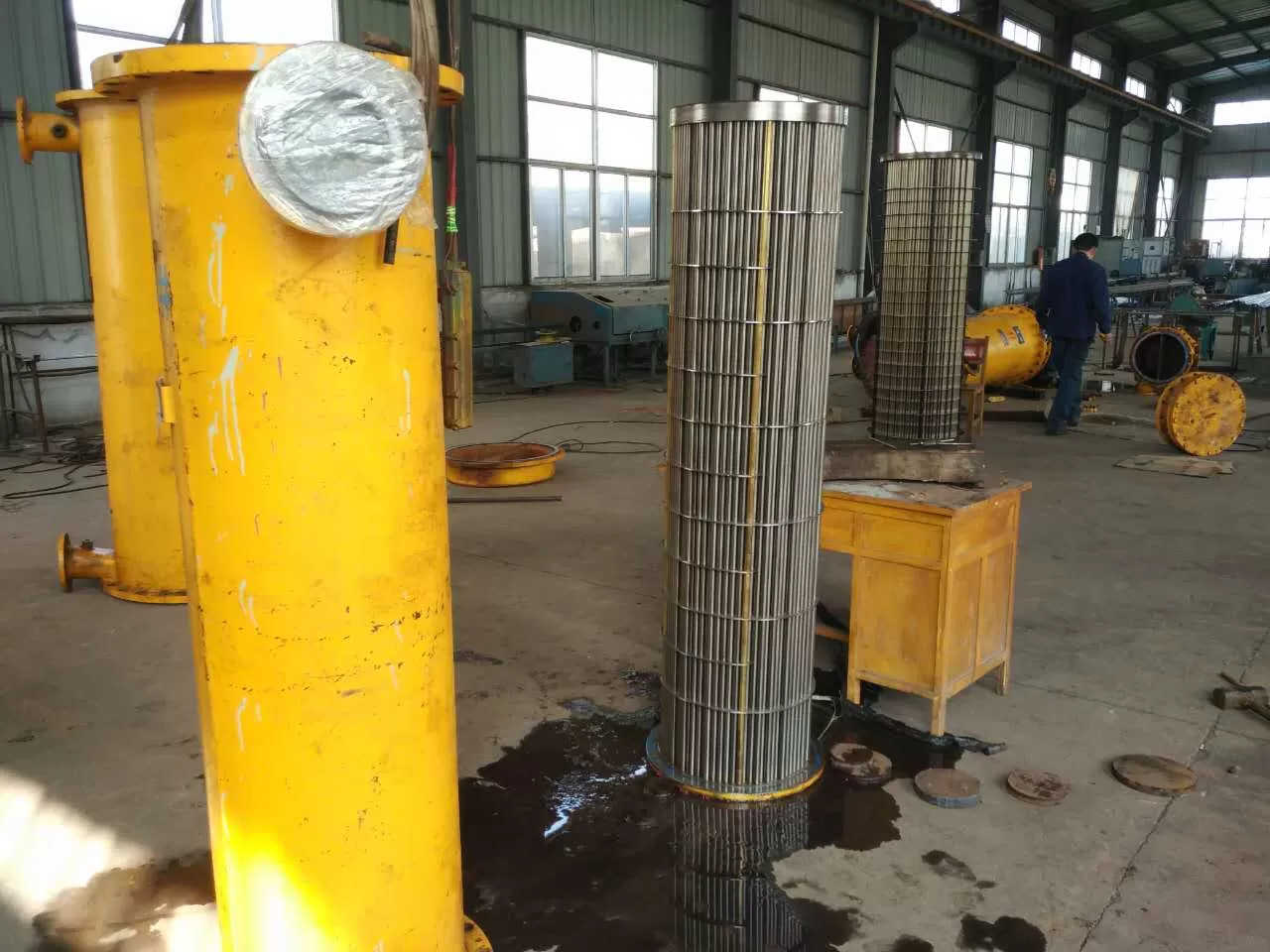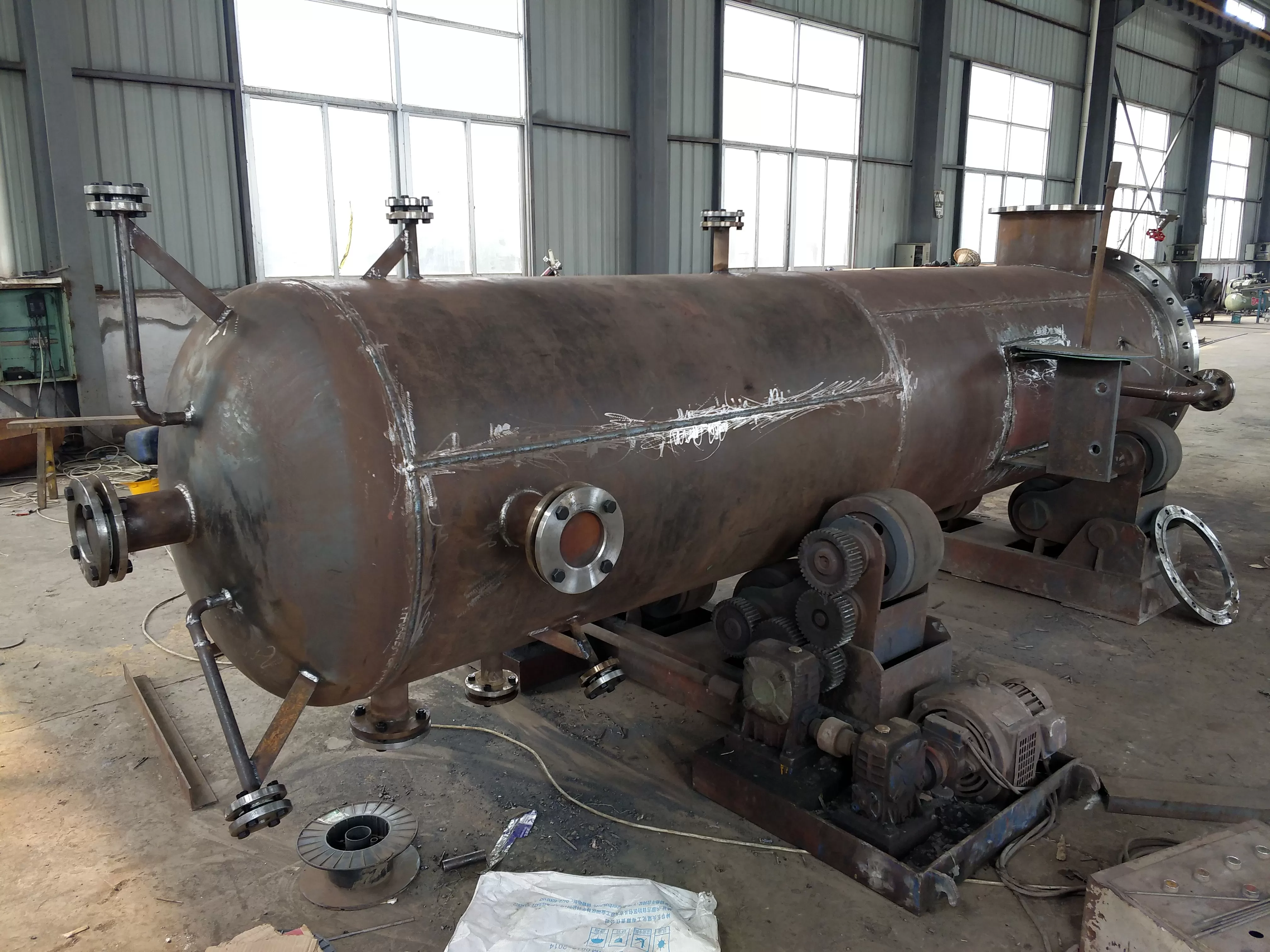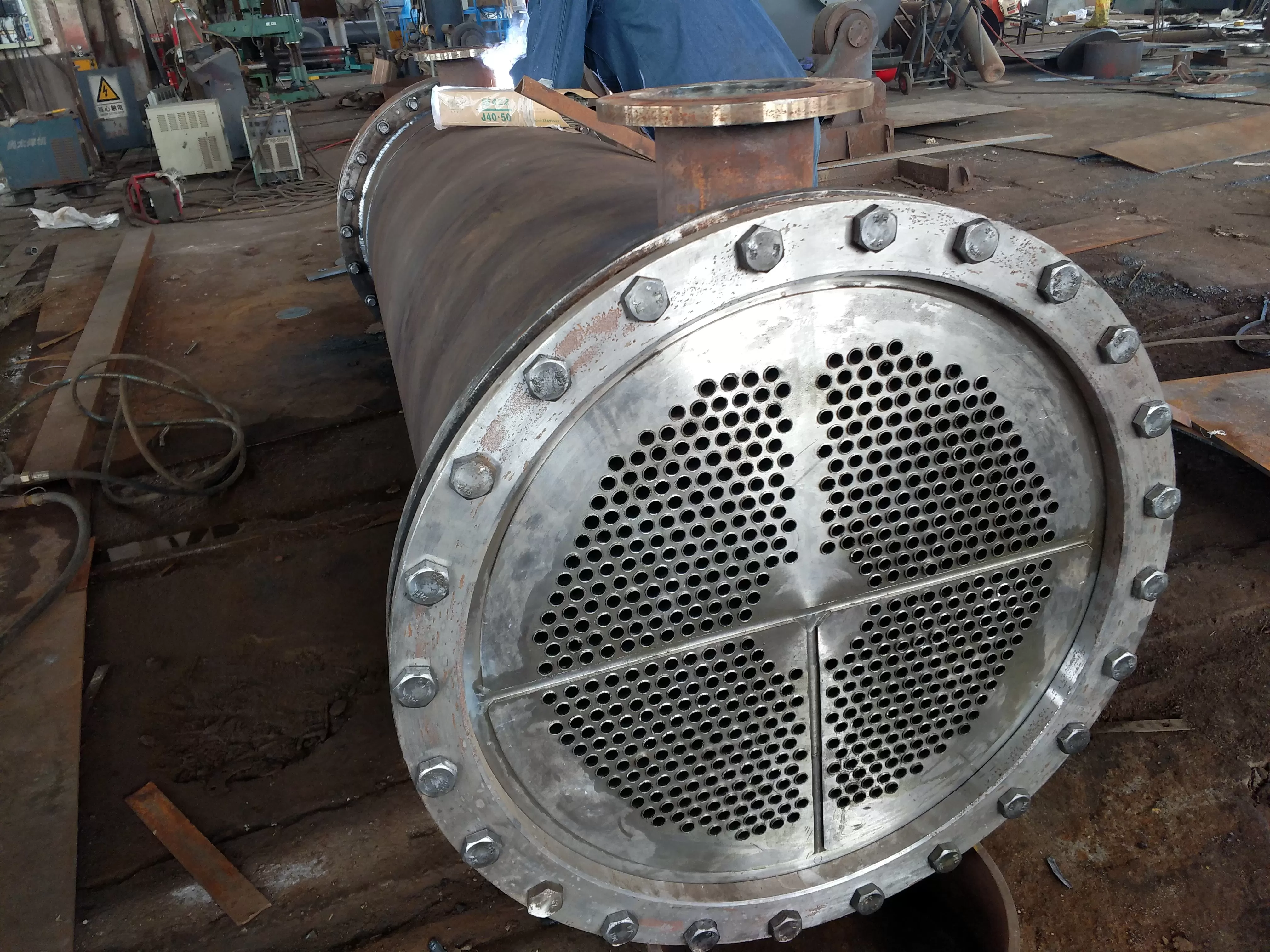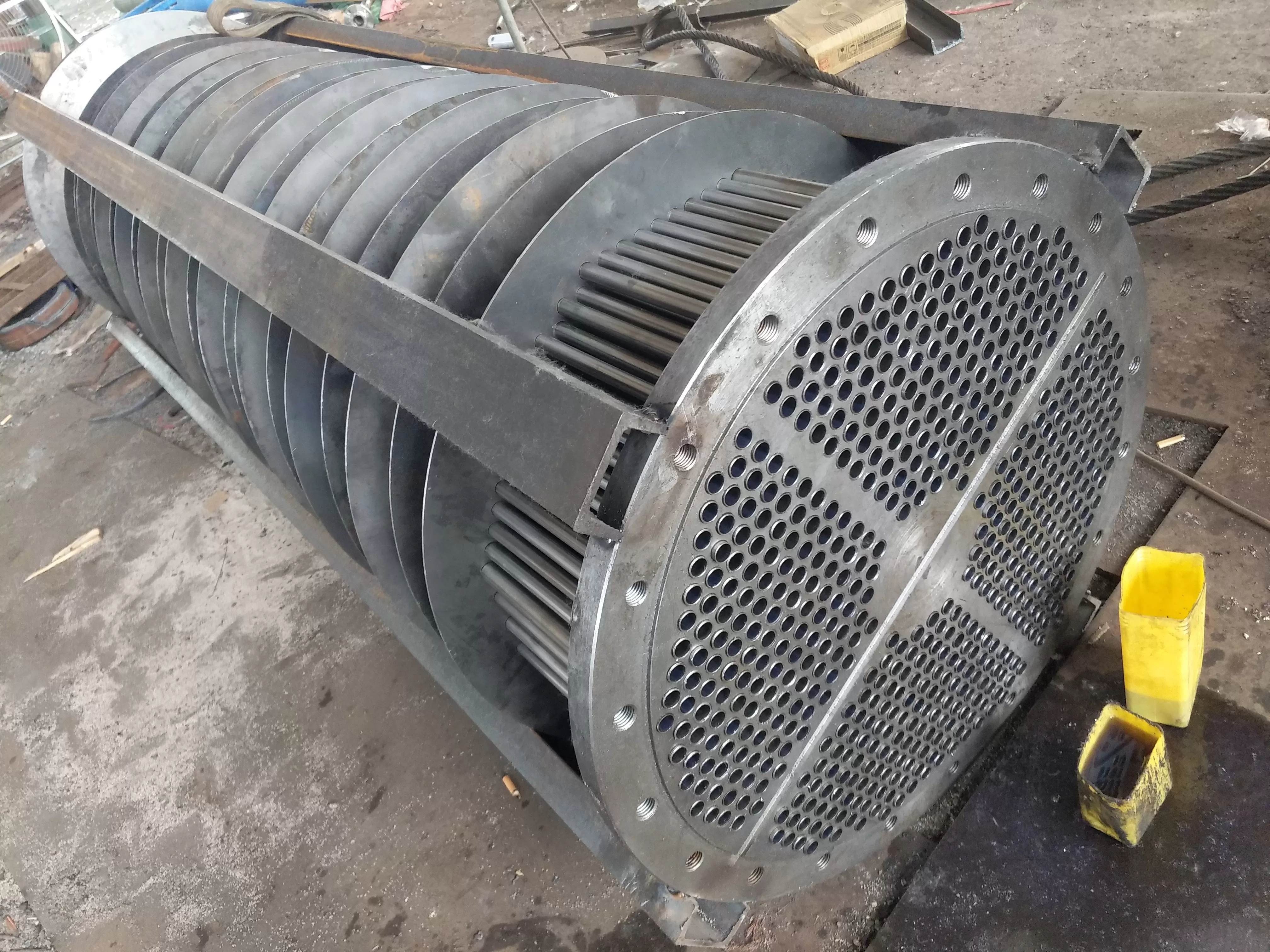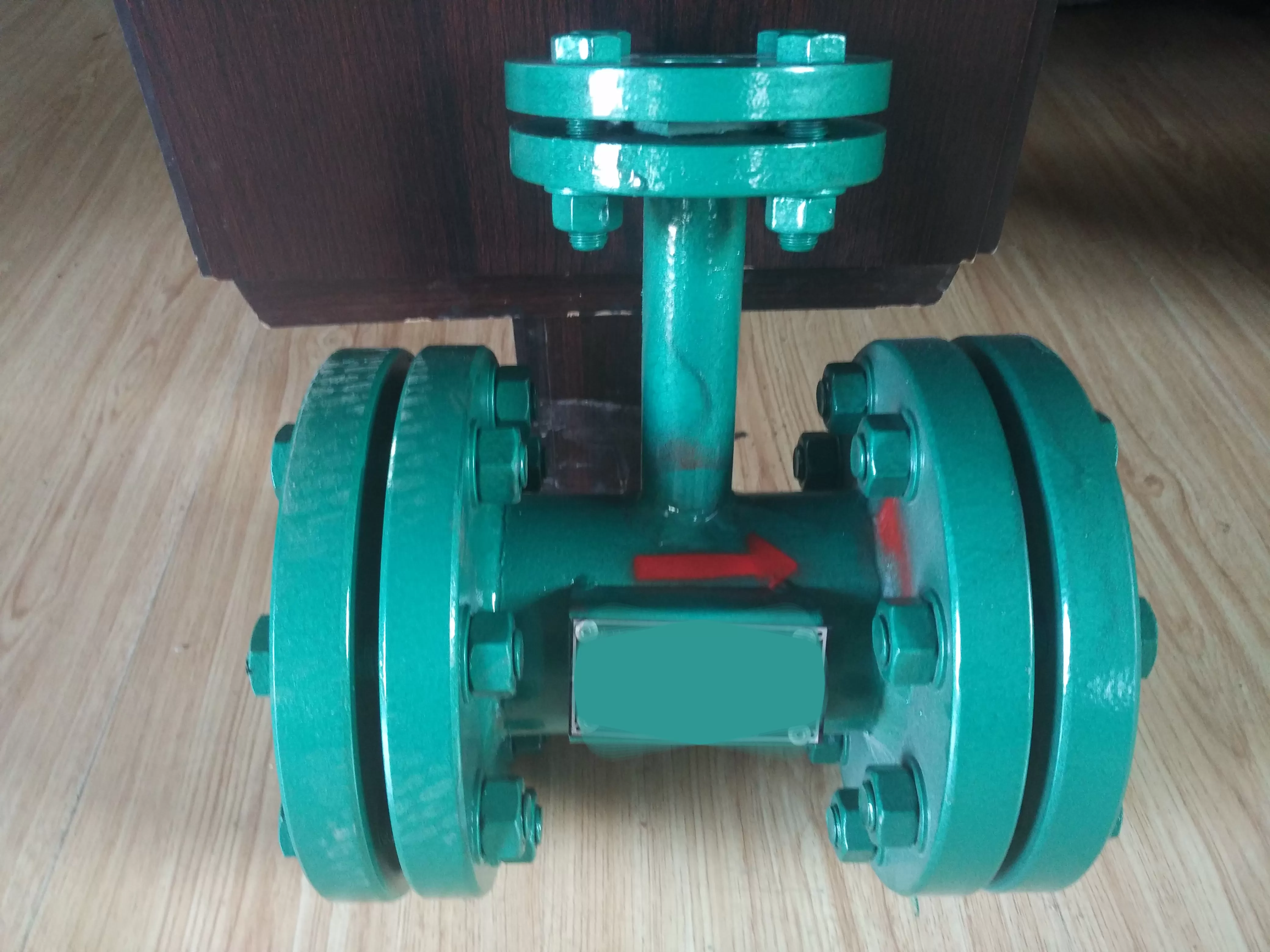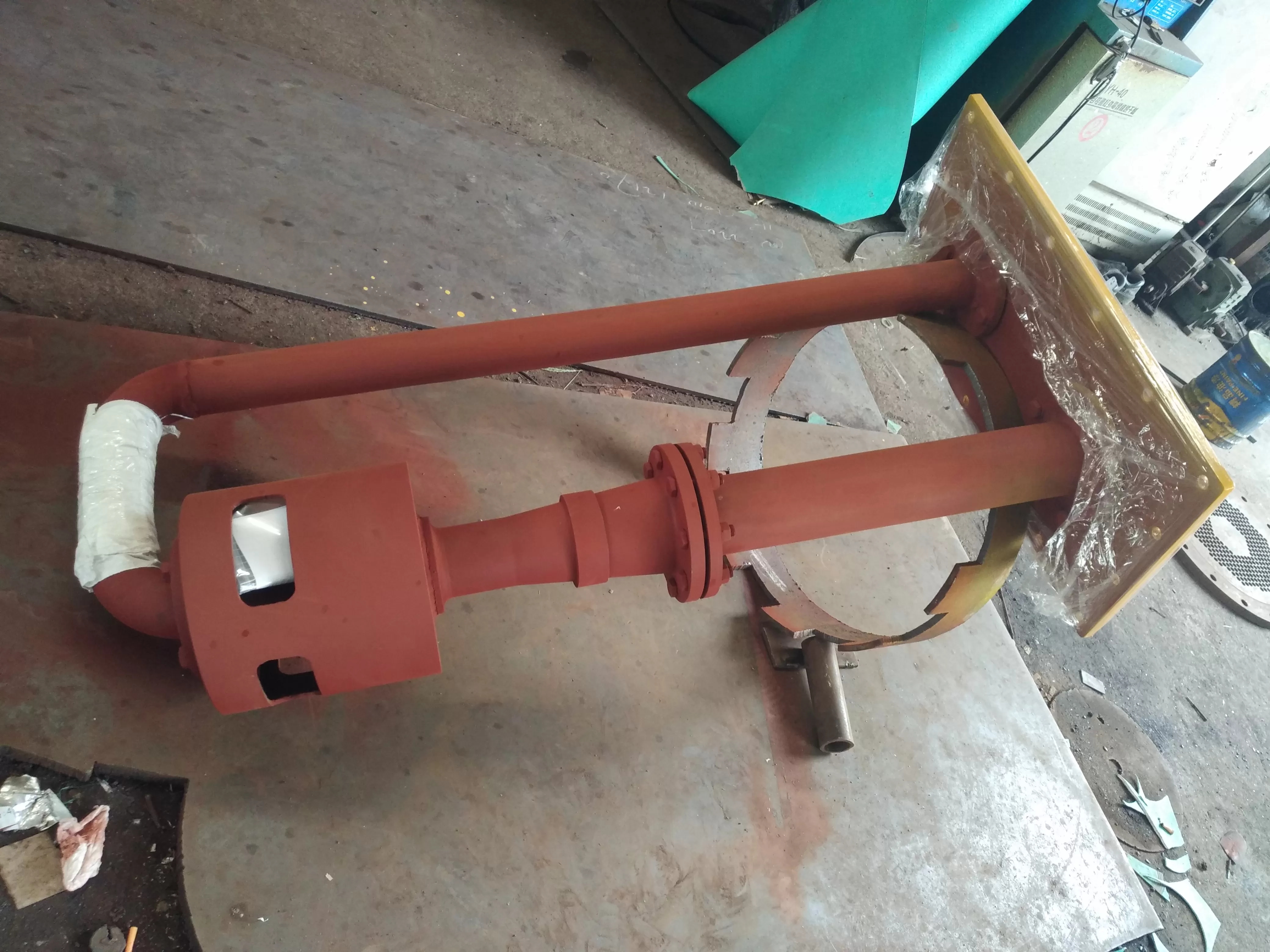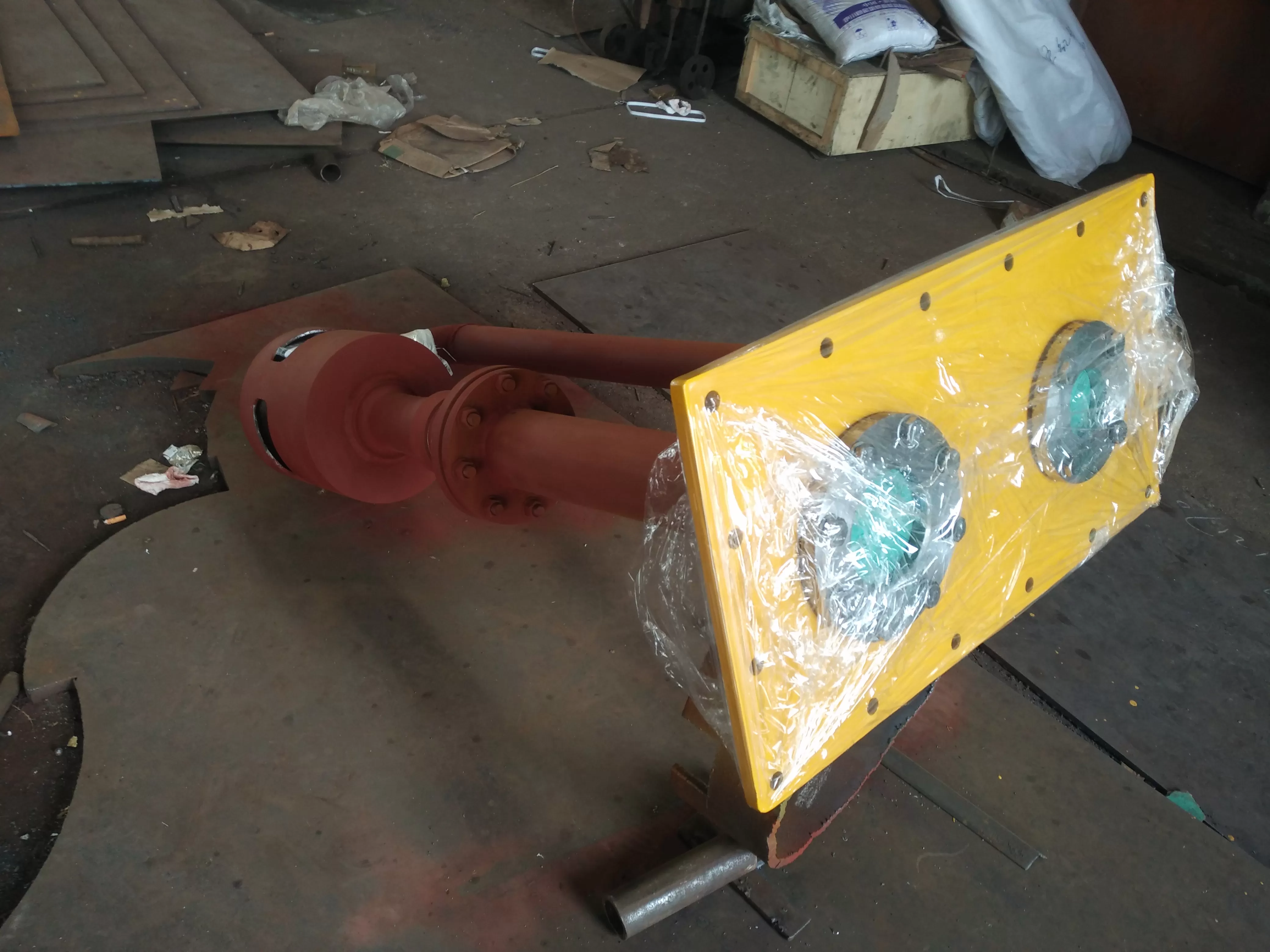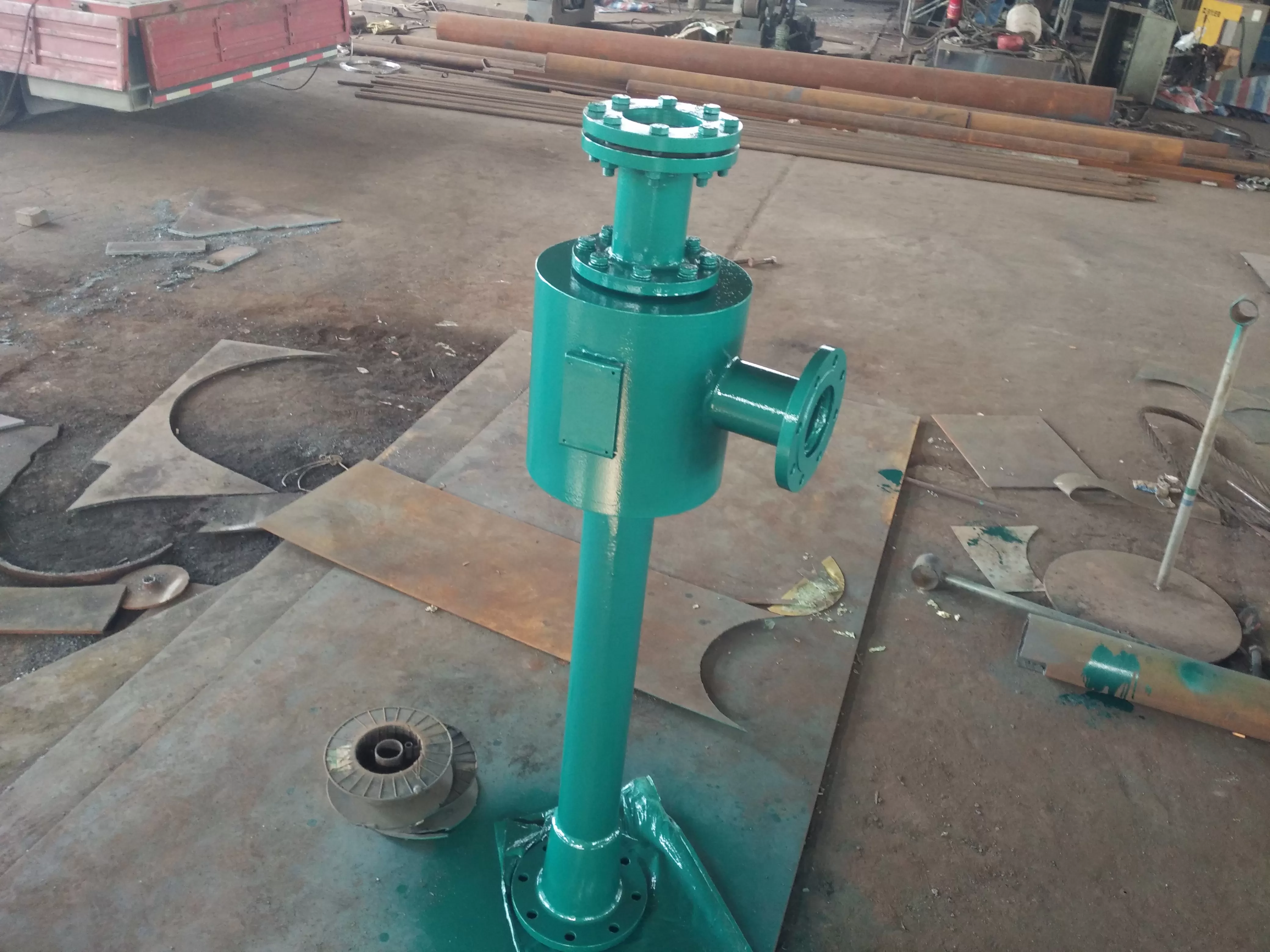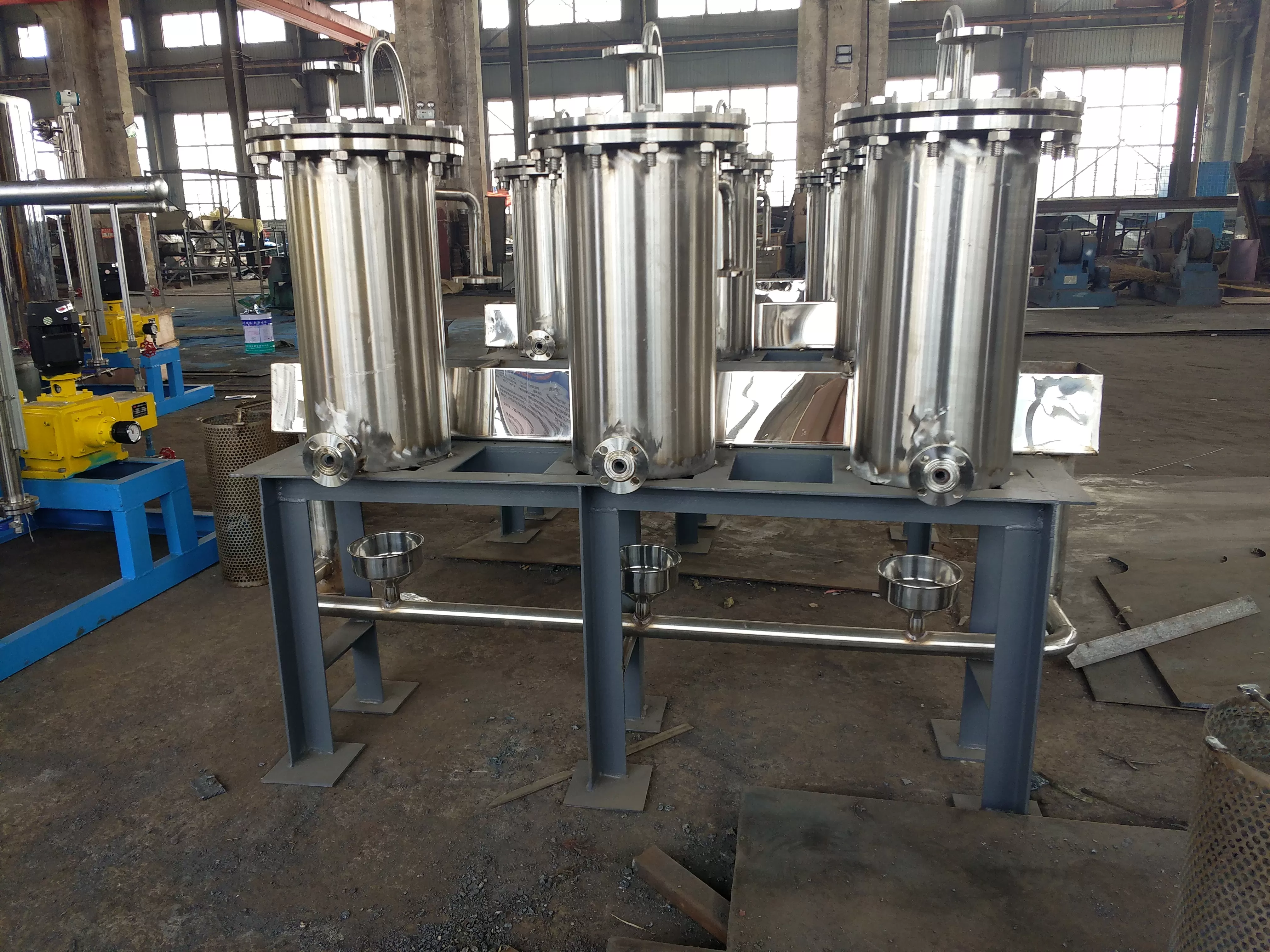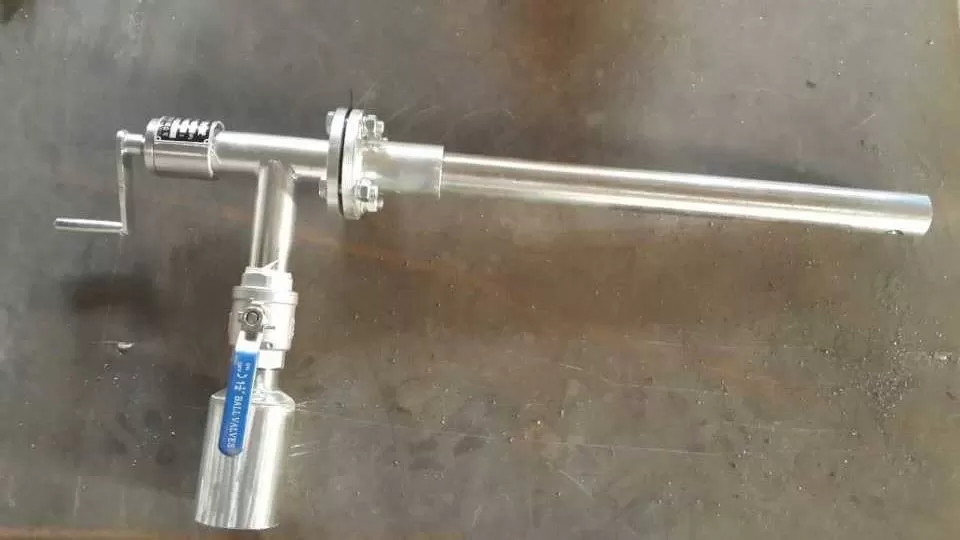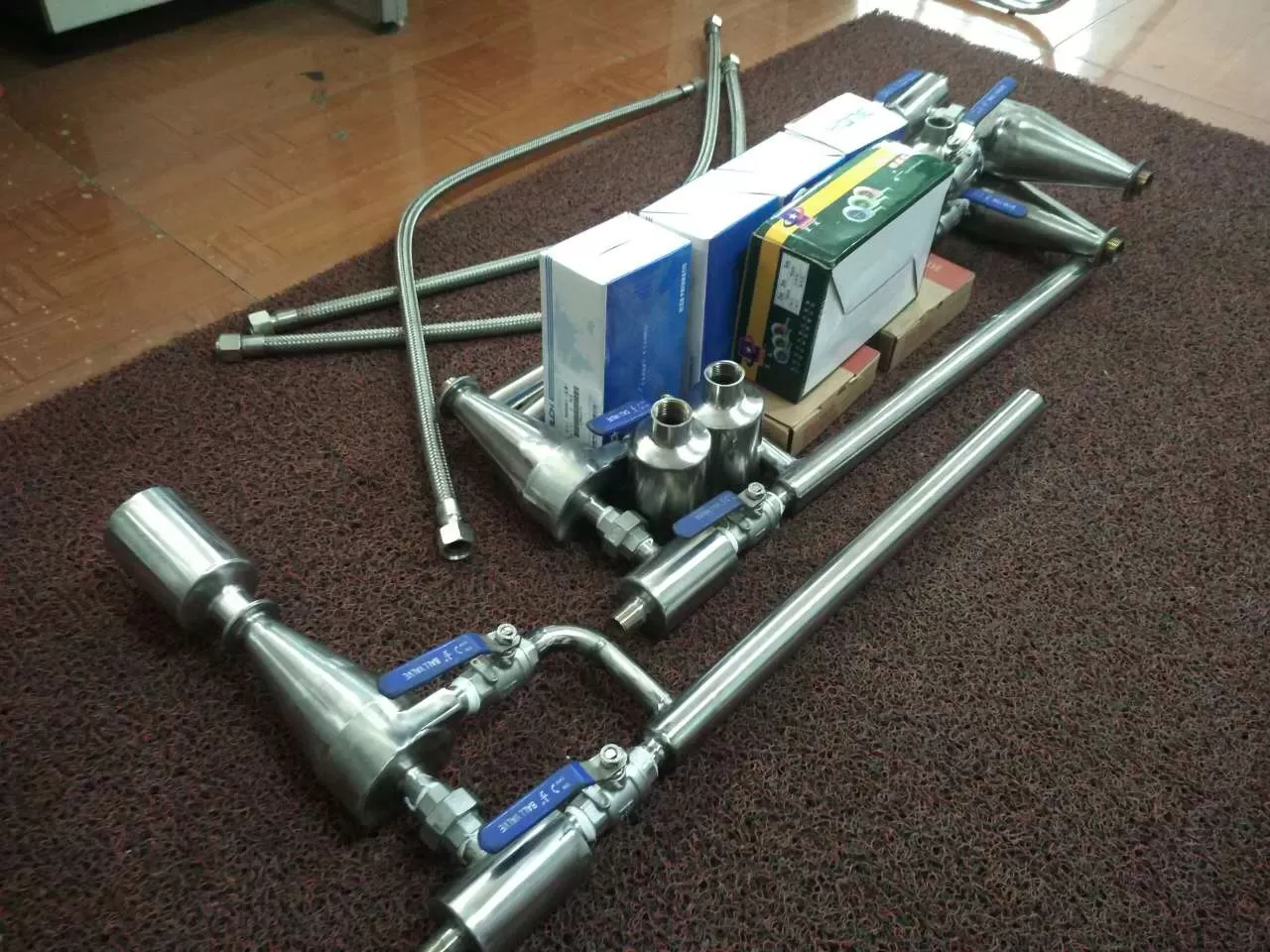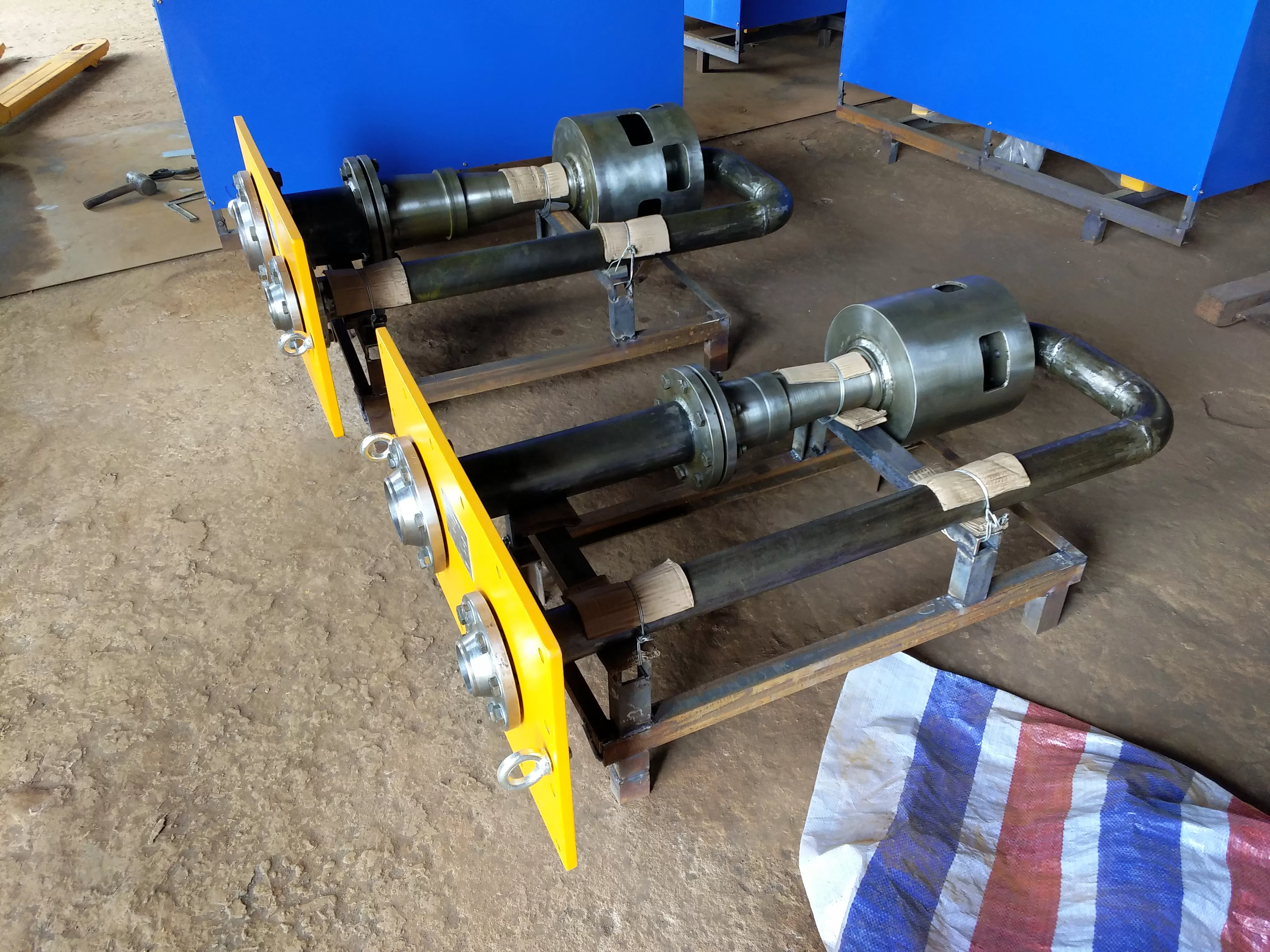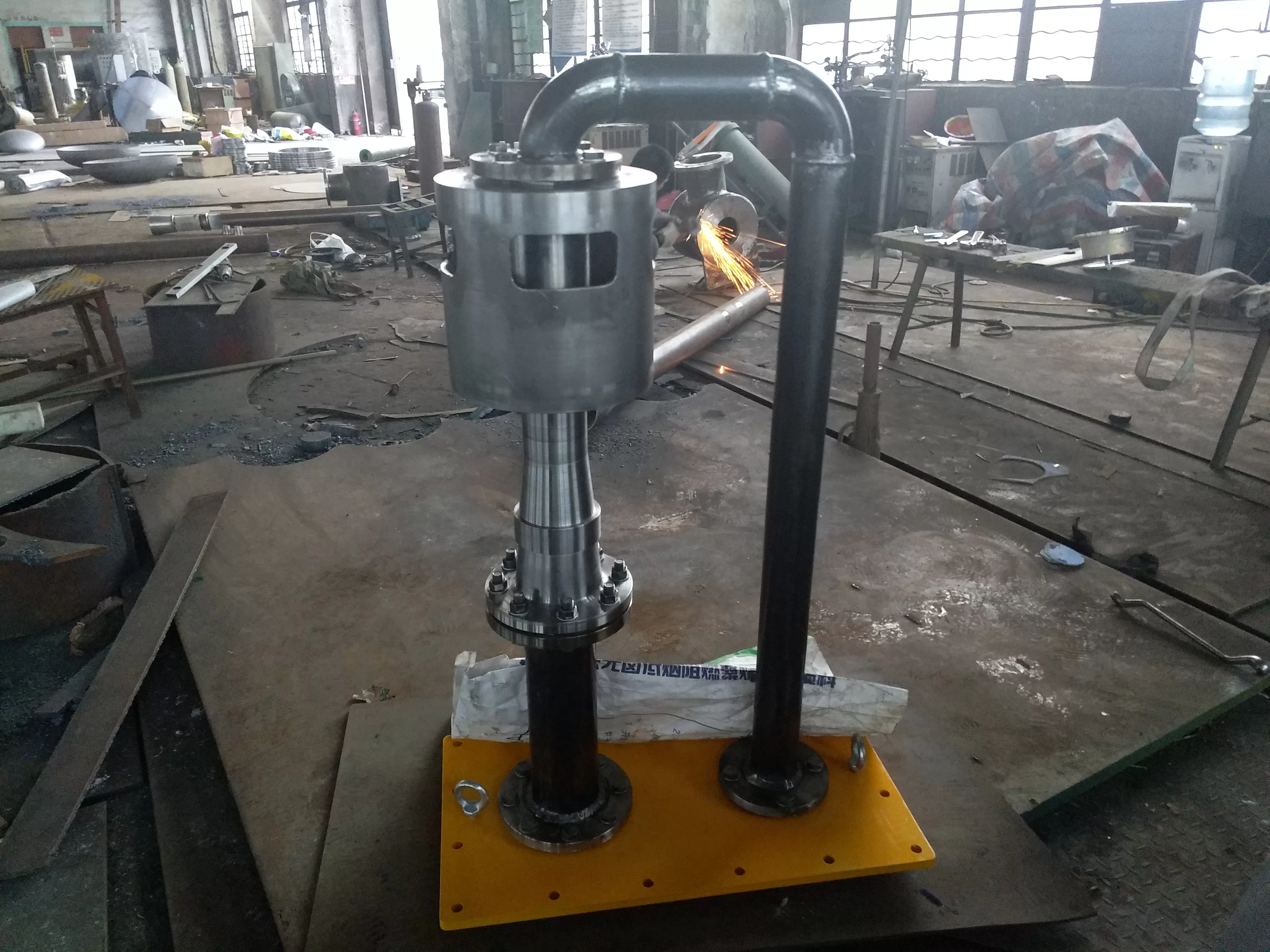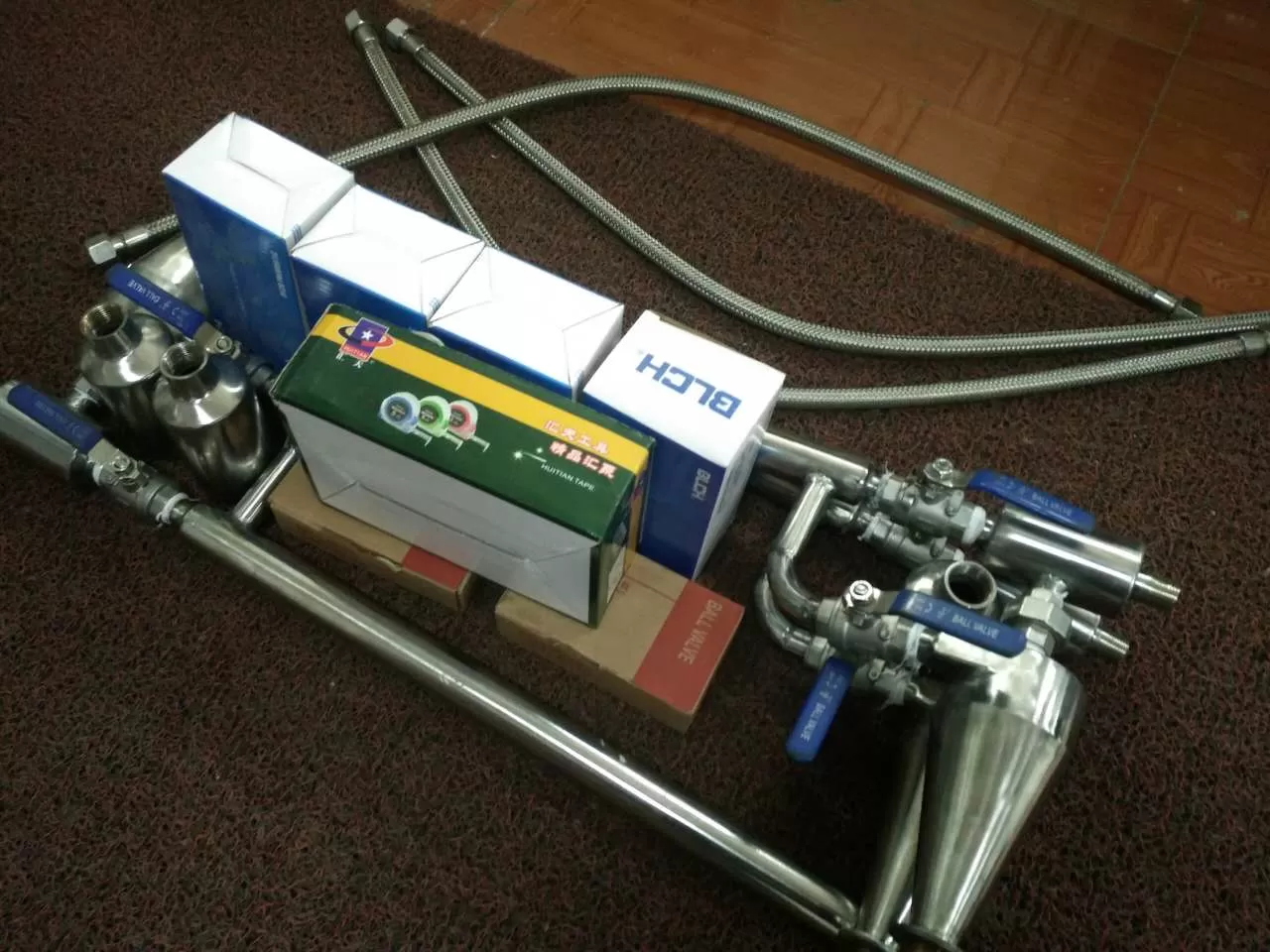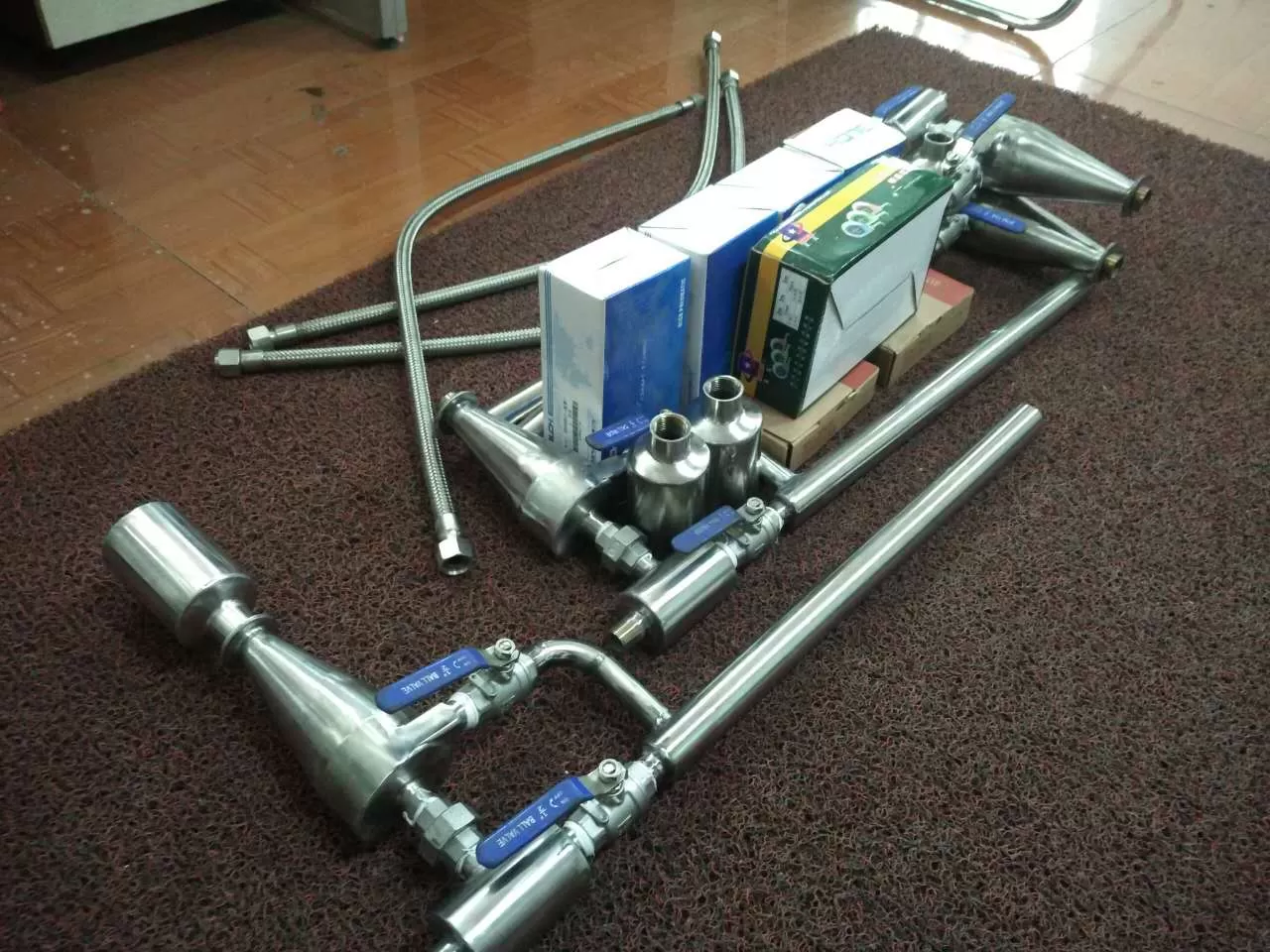Rotary membrane deaerator - Composition:
1. The rotary membrane deaerator consists of a deaerator head (tower) and a deaerator water tank. The deoxygenation head mainly consists of a rotary membrane separator, water grates, fillers, etc.
2. The attachments include: safety valve, liquid level gauge, thermometer, pressure gauge, water seal, balance container, electric or magnetic flap, etc.
Rotary membrane deaeration water tank - construction:
The rotary membrane deoxygenation water tank is used for water storage and buffering, as well as heating and auxiliary deoxygenation during boiler water supply. The water tank matched with the rotary film deaerator of a 300 MW thermal power unit is equipped with heating steam pipes, distribution pipes, reboiler pipes, anti rotation plates, and other necessary components and interfaces.
Heating steam for deaerator head of rotary membrane deaerator:
The heating steam of the deoxygenation tower is connected to the rotary membrane deoxygenation tower through the steam conduit in the upper part of the water tank, and the lower part is sent to the bottom of the rotary membrane deoxygenation tower through the steam pipe. When steam is sent to the bottom of the deoxygenation tower, injection method is adopted. When delivering steam to the tower, the vapor containing oxygen above the water level in the water tank is carried out in parallel, reducing the pressure drop of the vapor oxygen above the water vapor interface to - low.
Distribution pipe of rotary membrane deaerator:
The deoxygenated water from the deoxygenation tower is directed to the distribution pipe through the down pipe and directly distributed to each outlet at the bottom of the water tank. Ensure that cold water can be directly sent to the outlet when the steam turbine is unloaded to prevent vaporization at the inlet of the feedwater pump.
Rotating film deaerator deaeration water tank reboiler tube:
The deoxygenation water tank is equipped with a reboiler tube, which is used for heating and deoxygenation during boiler water supply and unit startup. It should be stopped immediately after the unit is started with load.
Anti rotation plate of deaerator deaerator deaerator water tank:
There are three water outlets at the bottom of the deoxygenation water tank, which are flush connected at the pipe ends and do not leave any protrusions inside. Install anti rotation plates at each outlet of the water tank to prevent water from swirling when the water level is low, and correspondingly increase the volume of the water tank. Experiments have shown that the swirling flow of water has a significant impact on the cavitation of water pumps. When using an anti rotation plate, the water level in the water tank must be maintained at a height of three times the diameter of the pipe. If there is an anti rotation plate, it can be lowered to 1.5 times or less.
Other accessories of rotary membrane deaerator:
Including the recirculation pipe, overflow pipe, shaft seal steam supply, low-level water discharge and other pipe openings of the feedwater pump. The valve stem - steam pipe is directly introduced into the heating steam pipe.
Rotary membrane deaerator -:
1. Stable operation and deoxygenation results, low-pressure rotary membrane deaerator ≤ 15PPb (ministerial standard), high-pressure rotary membrane deaerator ≤ 7PPb.
2. Strong adaptability to changes in unit load, especially for heating units and sliding pressure units. Can operate at 50% output and maintain qualified dissolved oxygen.
3. Can meet the sliding and constant pressure operation of the unit.
Scope of use for atmospheric rotary membrane deaerator and pressure rotary membrane deaerator:
The working pressure of the atmospheric low-pressure deaerator is 0.02Mpa, and its corresponding saturation temperature is 104 ℃. Dissolved oxygen is ≤ 15PPb (according to the ministerial standard). This type of deaerator is suitable for deoxygenation of boiler feedwater with low pressure parameters, and other purposes. Its output range is 5-300t/h.
The pressure type high-pressure deaerator has a working pressure of 0.5Mpa and a working temperature of 158 ℃. It is suitable for - and high-pressure boilers.
The pressure type deaerator has a working pressure of 0.3Mpa and a working temperature of 130 ℃. It is suitable for pressure boilers.
Low level deaerator technology -:
1. The low pressure deaerator is mainly installed directly on the ground, especially suitable for supporting gas and oil furnaces, which can reduce civil and installation costs (80%), and has a simple layout;
2. Due to the low position arrangement of the rotary membrane deaerator, cavitation problems occur in the feedwater pump. Therefore, it is necessary to design an anti cavitation device in the feedwater pump or the outlet pipe of the rotary membrane deaerator. Thermal power plants or some thermal power units usually have rotary membrane deaerator installed above 12 meters to avoid cavitation of the feedwater pump. The operating mode is the same as that of atmospheric rotary membrane deaerator.
3. The form of low-level deaerator is a low-level rotary membrane deaerator. The oxygen content in the effluent is ≤ 0.015mg/L.
4. Realizable mechatronics integration
(1) The steam separator is composed of a bracket, exhaust pipe, and packing, and mesh packing is selected as the separation packing. To simplify the equipment, the steam water separator and the upper manhole of the deoxygenation tower are combined into a body. During maintenance, the manhole cover should be removed together with the steam water separator.
(2) The high pressure heater drainage piping adopts a perforated pipe for water distribution, which is a side down spray type. The interior of the perforated pipe is detachable, and the expansion end is fixed with a T-shaped head.
(3) The steam conduit is uniformly distributed at the lower part of the deoxygenation tower, and the down pipe is located in the center, which is connected to the corresponding pipe mouth on the upper part of the water tank. The steam conduit and down pipe are the main interfaces for on-site installation, and should be equipped during manufacturing.
(4) The support legs of the deoxygenation tower shell are mainly used for lifting and aligning during installation, and are connected to the water tank support leg seat with flanges.
Protection and alarm of rotary membrane deaerator:
(1) A sufficient number of fully open safety valves are installed on the deaeration water tank and deaeration tower, and the number and specifications of safety valves should meet the design technical specifications.
(2) The rotary membrane deaerator should be equipped with local and remote water level gauges, as well as high and low water level alarm devices and dangerous high and low water level action devices.
(3) The sliding pressure operated rotary film deaerator can eliminate the pressure regulating valve and install an emergency shut-off valve.
(4) Add emergency water supply to open the water pump (or valve).
Working principle of rotary membrane deaerator:
To prevent corrosion of the rotary membrane deaerator and its pipelines, it is necessary to remove dissolved oxygen and other gases in the boiler feedwater. To ensure the safe operation and long-term use of thermal equipment. The principle of rotary membrane thermal deoxygenation is based on Henry's law and Dalton's law. For gases dissolved in water, under a constant pressure, the higher the temperature of water, the lower the solubility. Thermal deoxygenation is the use of steam to heat the feedwater to the saturation temperature at the corresponding pressure. The partial pressure of steam will be close to the total pressure on the water surface, and the partial pressure of various gases dissolved in water will be close to -. Therefore, water does not have the ability to dissolve gases, and gases dissolved in water will be precipitated, thereby removing oxygen and other gases from water.
Form of rotary membrane deaerator:
-The main forms of type - rotary membrane deaerator include atmospheric rotary membrane deaerator (low-pressure rotary membrane deaerator) and pressure rotary membrane deaerator (high-pressure rotary membrane deaerator, - pressure rotary membrane deaerator). The layout of type - rotary membrane atmospheric low-pressure deaerator is divided into high-level layout and low-level layout. There are two types of operation modes: fixed pressure and sliding pressure. The connection arrangement between the deaerator head and the water storage tank can be divided into two types: vertical and horizontal.
Rotating membrane deaerator in system -:
(1) Exhaust system - changed to two directions: towards the atmosphere; Add an exhaust pipe and lead it towards the neck of the steam turbine condenser. In order to ensure that the dissolved oxygen is qualified when the boiler is filled with water and the unit is started, a pipeline leading to the vacuum extraction system inlet is installed on the negative pressure pipeline leading to the condenser to ensure that the rotary membrane deaerator operates under negative pressure when the steam turbine shaft seal is not supplied with steam. When the steam turbine is driven to the neck of the condenser, and the water temperature of the rotary membrane deaerator reaches 107 ℃ or above after the turbine is loaded, it is changed to exhaust steam (gas) to the atmosphere. Both the exhaust main and branch pipes are equipped with corresponding valves.
(2) Emergency water supply pipe for low water level. To prevent the positive system from replenishing water when the water level of the rotary membrane deaerator drops to a dangerous low water level, a direct replenishment system from the chemical desalination water tank is added. It can be installed with pipelines or connected to the positive water supply pipeline. But it is necessary to ensure that the pump and electric valve can be opened flexibly and conveniently. The use of sliding pressure operation in the rotary membrane deaerator not only avoids complex operating procedures during start-up and operation, but also enables the unit to operate economically. After research, it has been found that the heat consumption of a 200 MW unit can be reduced (3-4) by using sliding pressure operation × 4.186 8 kJ/(kW? H), can save 800 tons of standard coal per year.
Rotary membrane deaerator in large generator sets - Test:
In order to meet the requirements of large power generation units for high-pressure rotary membrane deaerator, the following experimental studies should be conducted on the rotary membrane deaerator of a 300 MW thermal power unit.
(1) Vacuum deoxygenation test.
(2) Random group sliding test.
(3) High load water dissolved oxygen test.
(4) Reduce feed water temperature and conduct variable load tests.
(5) Random sliding stop test.
(6) Instant direct drainage test.
(7) Exhaust volume test.
(8) Water skirt area and flow rate test of rotary membrane tube.
Technical parameters of rotary membrane deaerator:
Pressure type rotary membrane deaerator (also known as high-pressure rotary membrane deaerator, high-level rotary membrane deaerator) GCM type operating pressure 0.1-0.98 MPa:
Technical parameters of rotary membrane deaerator and thermal deaerator: atmospheric rotary membrane deaerator (also known as low-pressure rotary membrane deaerator, low-level rotary membrane deaerator) DCM type operating pressure 0.02-0.08 MPa:
| 型號(hào) | 除氧器額定出力t/h | 水箱有-容積m3 | 工作溫度(℃) | 工作壓力mpa(表壓) | 進(jìn)水溫度(℃) | 設(shè)計(jì)溫度(℃) | 設(shè)備凈-(kg) | 備注 | | mcy-10 | 10 | 5 | 104 | 0.02 | 20 | 250 | 3680 | 具
體
尺
寸
規(guī)
范
參
見(jiàn)
總
圖 | | mcy-20 | 20 | 10 | 104 | 0.02 | 20 | 250 | 4570 | mcy-35 | 35 | 15 | 104 | 0.02 | 20 | 250 | 5616 | | mcy-40 | 40 | 20 | 104 | 0.02 | 20 | 250 | 8320 | | mcy-50 | 50 | 22 | 104 | 0.02 | 20 | 250 | 9556 | | mcy-75 | 75 | 35 | 104 | 0.02 | 20 | 250 | 12200 | | mcy-85 | 85 | 35 | 104 | 0.02 | 20 | 250 | 12200 | | mcy-130 | 130 | 40 | 104 | 0.02 | 20 | 250 | 18750 | | mcy-150 | 150 | 40 | 104 | 0.02 | 20 | 250 | 18100 | | mcy-300 | 300 | 70 | 104 | 0.02 | 20 | 250 | 23885 |
|
|
可以代用戶設(shè)計(jì)任何規(guī)格除氧器����,具體尺寸參數(shù)詳見(jiàn)設(shè)備圖紙 |
| 五、-用高壓除氧器規(guī)格型號(hào): |
| 型號(hào) | 除氧器額定出力t/h | 水箱有-容積m3 | 工作溫度(℃) | 工作壓力mpa
(表壓) | 設(shè)計(jì)溫度(℃) | 設(shè)備凈-(kg) | 備注 | | cyg-150 | 150 | 40 | 158 | 0.5 | 300 | 19250 | 具
體
尺
寸
規(guī) | 范
參
見(jiàn)
總
圖 | | cyg-180 | 180 | 50 | 158 | 0.5 | 300 | 21770 | | cyg-225 | 225 | 70 | 158 | 0.5 | 300 | 26300 | | cyg-420 | 420 | 120 | 158 | 0.5 | 300 | 42800 | | cyg-680 | 680 | 180 | 158 | 0.5 | 300 | 62900 |
|
|
| 可以代用戶設(shè)計(jì)任何規(guī)格除氧器����,具體尺寸參數(shù)詳見(jiàn)設(shè)備圖紙 |
